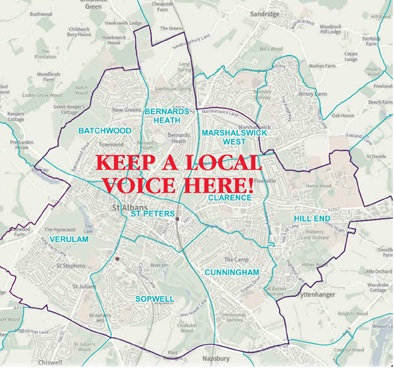All change for St Albans council
In December 2024, the government published plans to merge district and county councils into unitary authorities by 2028, so St Albans City and District Council (SADC) is set to disappear. It will be merged with all or several of Hertfordshire’s ten district councils. The new authority will pick up functions now covered by Hertfordshire County Council which is also to be abolished. The exact footprint of the new authority is yet to be determined but we know it is very unlikely the headquarters will be in St Albans.
The planned change has particular impact on central St Albans. This is because SADC directly manages this very important area, unlike in other parts of the district such as Harpenden, Sandridge and Redbourn where local matters are devolved to parish councils – locally elected secular bodies sometimes called town councils. The central (city neighbourhoods) area is ‘unparished’ so there will be a gap when SADC is abolished. For this reason the Civic Society is supporting the creation of a city neighbourhoods parish council to fill SADC’s role in conserving our city’s distinct characteristics; managing resources such as the market, community spaces, parks and allotments; thereby also allowing its people and businesses have a local democratic voice and a channel to the new large-area unitary authority.
Map of the central St Albans ‘unparished/at risk’ area within the purple boundary line
To move things forward SADC has agreed to review its parish and town council arrangements. The legal process for this is called a Community Governance Review (CGR) and the initial consultation period is from 4 August 2025 to 6 October 2025.
Central St Albans needs a voice
Having a unitary authority will be a big change with many positives and many points of concern and much still to shake down. For central St Albans there’s one significant problem. Our city neighbourhoods are directly managed by St Albans council. When it disappears so too will the local management of our parks, our allotments, our markets and our historic city centre.
The Civic Society strongly believes that the creation of a parish council for the current ‘unparished’ central part of our fine city is the best way to ensure local people feel fairly represented and that local democracy evolves alongside changing communities. A parish council is simply an elected body with a community focus forming the first tier of local government, exactly like Harpenden Town Council.
We want local people to ask for a voice for our city neighbourhoods by emailing CGR@stalbans.gov.uk to ask that a parish council be created for central St Albans. You need to include your name and address (your details will be kept confidential).
Responding to this consultation is essential. Without a high response rate the decision will be that there is no appetite for local representation. There is a very short window of opportunity to MAKE YOUR VOICE HEARD (the consultation closes on 6 October 2025).
There’s more on the consultation process for creating a new parish council on the SADC CGR web page.
Background to the changes
The English Devolution White Paper is about merging the current two-tier system of local government.
In Hertfordshire we have our County Council, looking after libraries, schools, social care, transport and other county-wide activities. Within Hertfordshire there are ten district councils including our St Albans City and District Council (SADC) which covers a smaller area including St Albans, Harpenden, Redbourn and Wheathampstead.
Hertfordshire’s local government district councils
Together with its associated Parish Councils, SADC covers areas such as rubbish collection and recycling, planning and building regulations, parks, markets, allotments, parking, and social housing.
Hertfordshire County Council initially planned to enter the fast-track process for reorganisation and devolution to become a single unitary council serving the 1.2 million people in the county and to postpone the 2025 election of councillors. This was shelved when district council leaders issued a joint statement objecting to the plan. They called for ‘a proper period of consultation’ and said: ‘A single unitary council for the county risks diminishing local representation, with decision-making that is remote from the communities we serve’. Joint proposals on an alternative to a single unitary authority, for example two unitary authorities covering Hertfordshire, are expected by end-November 2025.



